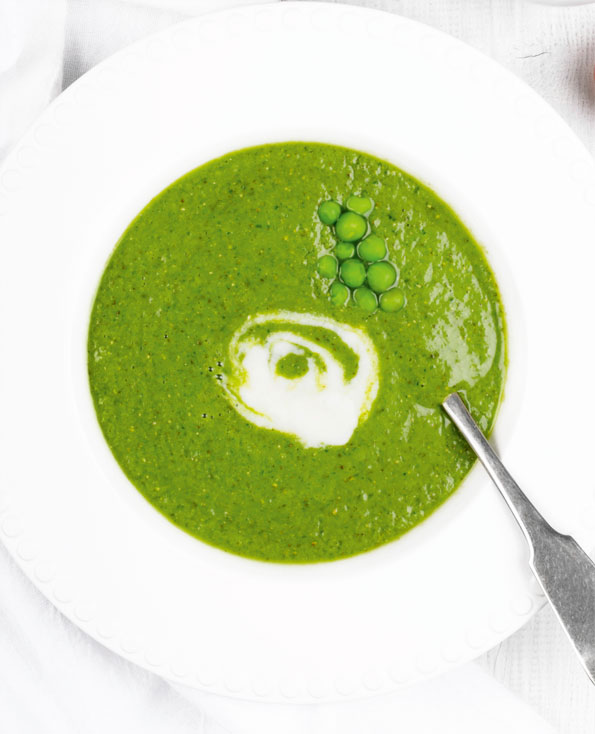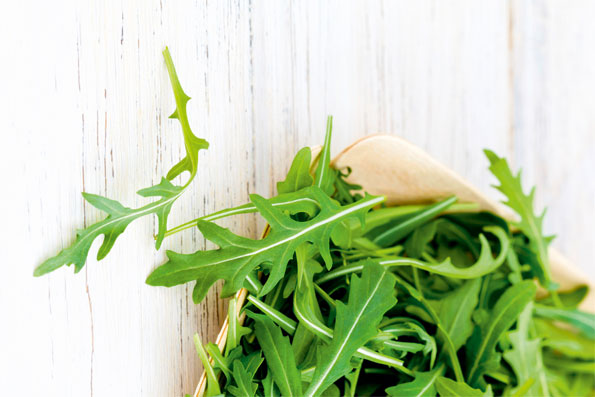I am about to grow soup. No, not the ready-to-eat variety, though how good would that be? But rather, I’m growing the ingredients for soup I saw at the supermarket and to which I have become somewhat addicted.
There are two: pea and rocket, and pea and mint. They are organic gourmet soups in high-end packaging with a high-end price tag, and I know that if I can grow the ingredients, The Partner – a chef in a former life – will be able to recreate them to an equal, if not higher, standard for next to nothing. And how difficult can it be to grow rocket, peas and mint? Especially now, when peas in particular will thank you for a bit of cool weather.

Pea soup crosses seamlessly from a winter warmer to a bright, spring dish.
Peas are a cool-season crop, but they’re sun bunnies too, so find a good, sunny spot where there’s a bit of shade during the heat of the day. And take note that while they like the air temperature to be low, they’re not happy about cold, wet feet. Well-dug, well-drained soil with good moisture retention and lots of organic material is their preference, and hold the nitrogen – they get their own from the air and cleverly store it along their roots. (When they’ve done their dash, dig them back into the soil and the nitrogen will be available to whatever you’re growing next. So clever.)
You can sow peas directly in the garden starting in early August, and extend your harvest season by planting every couple of weeks after that. Or, you can plant varieties that mature at different times.Check the packet, but as a rule of thumb, put the seeds into the ground at a depth of 3cm, 5cm apart, in double rows about 10cm apart. Peas are an instant gratification plant and will appear in about a week, although it’ll be another 50-odd days till you’re eating them. They like to be weeded, watered and well-supported, and will benefit from a trellis to hang on to and keep them above the jaws of slugs and snails. Pick them early before the pods become tough, cook gently and whack them in the blender with rocket or mint. Experiment with other add-ons, such as pesto, garlic or pears.

More than a hint of mint.
A friend asked me the other day how to grow mint. “More to the point,” I spluttered, “is how NOT to grow it.” I’m somewhat surprised it’s not on DOC’s hit list, because the second you let it out of a container, it’s turned itself into a determined, not very attractive ground-cover and there’s no stopping it.
You can buy mint at the garden centre, but it also grows easily from cuttings. Honestly, you can virtually throw a bit down on the soil and it’ll take root, but it’s best to plant it in a container in moist, rich soil and keep it in partial shade. You can plant it in a plastic pot with the bottom taken out and sink it into the garden, but I think it looks great in a big, terracotta pot beside the herb garden or just outside the garden shed, preferably under the garden tap.
The only thing that seems to bother it is rust, so if brown spots appear on the leaves, trim it back to about 3cm above the ground to promote new growth. If it’s still rusty, cremate the plant and get a new one.

Inspiring, great greens.
Rocket, I’m pleased to report, will grow happily all year round. Certainly I’m expecting better results from it now than I had in the summer, when it went to seed every five minutes because we were having a drought. Most unreasonable. So, constant moisture and fertile soil with good drainage is essential.
Get heaps of rotted manure or compost into the soil, and make sure it’s well drained. Plant seedlings about 30cm apart either directly into the soil or into pots. Blink, and they’ll have germinated, and you’ll be picking leaves in about four weeks. That’s my kind of plant. All you need to do is keep sowing to feed your soup habit.

Easy peasy sweet peas.
Sweet peas are not suitable for late winter soups – as far as I know. But since we’re talking peas, you can plant the summer-flowering varieties now. There are three types: winter-flowering, spring-flowering and summer-flowering. Autumn is the best time to sow seeds of winter and spring-blooming sweet peas, but summer-flowering types grow better if you sow them in winter.
Sweet peas like sun and well-drained, humus-rich soil. There are two schools of thought on sweet peas. One says soak the seeds before planting; the other, poke them into moist soil. One says sow them in pots first; the other recommends sowing directly into the ground. If you’re putting them in pots first, leave them outside as they germinate at low temperatures (they may grow spindly if you keep them in a greenhouse). Some say to fertilise at planting time, others say don’t go overboard.




